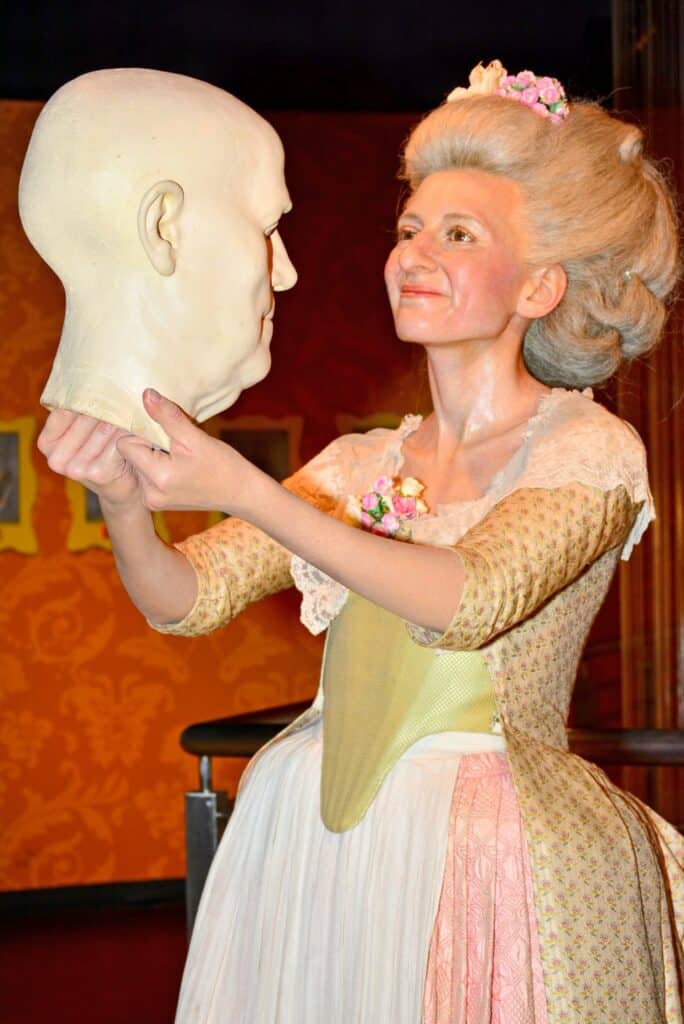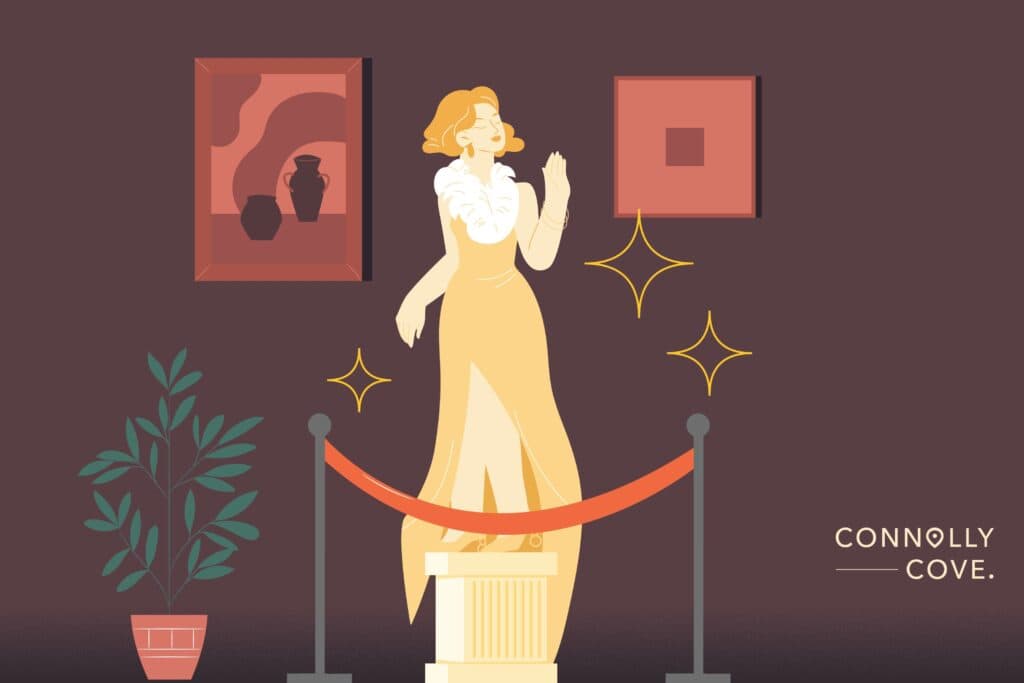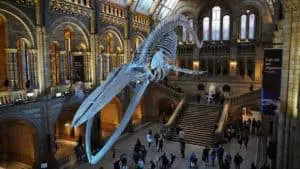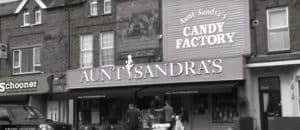Marie Tussaud: The Brilliant Artist Behind the World’s Most Prominent Wax Museums

Updated On: November 09, 2023 by Noha Basiouny
Humans build museums to celebrate art, culture, music, science, history, technology, heritage, and so many other things, including, well, weirdness.
For example, art museums celebrate all forms of art, and natural history museums look into the evolution of animals and plants and the development of our ecosystem and nature in general. History museums tell stories of old civilisations and how our ancestors used to live, and weird museums highlight quite bizarre things such as broken relationships, tap water, and dog collars.
Wax Museums
Wax museums display collections of life-size wax sculptures of well-known characters, whether they happen to be royalties, artists, sports or historical figures, or, sometimes, even criminals! When done right, sculptures come out almost identical to whoever they resemble, providing the audience with an almost real experience of meeting those personalities.
In this respect, one cannot bring up wax museums without mentioning Madame Tussauds, the world’s most significant and well-known wax museum chain. This wax museum has so many branches across the globe.
While the original one and the first to be established is in London, there are 21 other similar museums bearing the same name in some of the world’s major cities, including Hong Kong, Sydney, Amsterdam, San Francisco, Hollywood and New York.
Likewise, no one can mention Madame Tussauds without telling the story of Marie Tussaud, the brilliant woman who revolutionised the art of wax modelling and established the first wax museum that turned into the world’s leading chain in this field of art. And that is basically what we are about to do.
So bring along a cup of tea or a coffee if you want, and let’s hop into it.
Marie Tussaud

Madame Tussauds is the name of the wax museum in London and all the other 21 branches under its supervision. Madame Tussaud, Marie Tussaud, is the artist who established the original one and whose fantastic work and great legacy inspired the establishment of those many branches.
So here is how the story of this brilliant artist goes.
Early childhood
Before she became Madame Tussaud, Marie had the last name Grosholtz. She was born in 1761 in Strasbourg in eastern France. While her father passed away while she was just a baby, her mother needed to work to care for her and make ends meet.
Lucky for Marie and the entire humanity, her mother started to work as a housekeeper for the famous Swiss wax modeller Philippe Curtius who, at the time, used to live in Bern, Switzerland, and so did Marie and her mother.
Curtius was initially a physician. But he was very into wax modelling and had a great talent for it which he used to simplify the basics of anatomy to others. He made illustrative anatomical wax sculptures that accurately depicted the inside of the human body. This made it easy for his students to approach anatomy as an exciting science rather than a horrible one.
On a more personal level, Curtius was a true gentleman. He cared for young Marie and treated her like he would treat his daughter—he never married, by the way. Marie also viewed Curtius as her father and followed him everywhere. Like a tiny happy kitten, she showed interest in whatever he was doing, so he spared no effort to teach her what he knew.
Since she was as young as six years old, Marie started learning about wax modelling from Curtius. He gave her the basic anatomical knowledge required to make sense of this art. This allowed her to experiment with wax from such a young age.
By time, Curtius found himself more and more drawn to wax modelling than medicine. So at some point, he made up his mind to give up his profession as a physician and become a full-time wax modeller, just like how Sir Arthur Conan Doyle would later quit medicine to dedicate all his time and energy to writing and the other dozen things he mastered.
Paris
This decision required Curtius to make some radical changes in his life, such as moving to Paris, the city of art. Marie and her mother also accompanied him there. Paris highly influenced Curtius and drove him even more to wax modelling. His life there turned into consecutive episodes of art practices, and he worked so hard to create his very first wax exhibition, which came to light in 1770.
Curtius’ talent turned out to be so magnificent that his exhibition attracted an incredible number of people. Soon enough, he gained a reputation for being a highly skilful wax modeller. He even became so successful that his collection was moved to the Royal Palace, Palais Royal, itself in 1776.
One of the most significant things that Curtius did and highly inspired Marie later in her life was creating sculptures of criminals. He understood that people were just as curious about criminals as they were about crimes, despite how much they hated both. Back then, there was no media to show them what criminals looked like, so he decided to be the first to do that.
So Curtius made another distinct collection of wax sculptures that depicted famous thieves. The location he chose to display this unique collection was also a smart move. It was a street in Paris nicknamed the Boulevard du Crime, which pretty much matched his unique collection.
Interestingly, the street was called so because it was full of theatres that showed crime plays every night, not due to the many crimes it witnessed.
Curtius proved no wrong at all. Once his second exhibition was open to the public, visitors flocked to it to satisfy their curiosity about criminals and the crimes they committed. Once again, the new collection was a great success, just like the first one.
First job
While Curtius was happily living his life doing what he loved the most, Marie was keeping close, watching, learning, and grasping every bit of knowledge he gave her. In 1777, when she was only 16 years old, Marie made her first ever sculpture representing Voltaire, the famous French philosopher, which is currently on display in the London museum.
Only a year later, when Marie turned 17, she started teaching art to King Louis XVI’s sister, Madame Élisabeth, in the Palace of Versailles. Although it does not take a genius to know that she got such a sophisticated job thanks to Curtius, if it also were not for her unique talent, she would not be able to keep it.
The French Revolution
Life went on very well for Marie for almost a decade more. She continued doing her job at the Palace of Versailles, learning from Curtius, making wax sculptures and sharpening her skills. But everything suddenly turned upside down and completely changed the course of her life.
In 1787, the French Revolution broke out and wreaked havoc in the entire country. Along with the royalists that were arrested at the time was Marie. She was sent to prison and sentenced to execution.
But if it were not for the help of a close friend of Curtius, Marie would have been killed. Yet, as her destiny requested otherwise, she was released a while later and once again, Curtius saved her life.

Death masks
However, the period that Marie spent in prison was a critical one in her life as a wax modeller. While she was there, she made death masks of her friends who were executed by the guillotine.
Even when she was released, once she knew that someone was beheaded or killed in a crime, she would rush to the crime scene and quickly take the impressions of the face while the head or the body was still bleeding. Then she would use these facial features to make a mask of the dead person.
It was apparently a combination of things that allowed Marie to do such a horrific job. It may be her early study of human anatomy that made her able to see freshly executed heads without being badly affected. She must have also been driven by her talent, passion for and uncontrolled devotion toward wax modelling, which filtered any disturbance and left her only with the actual model.
The fact that this practice seemed to match the entire atmosphere of France at the time must have also reduced its heaviness and even made it more of a normal practice. In addition, a wax modeller’s job was to make masks and sculptures mostly of the dead. A successful modeller must not have any problem with seeing corpses, which is a trait Marie proved to have.
Marie was super active and prolific during the period. She made her own collection of death masks, portraits, and many other waxworks, which would very soon be her doorway to fame. Among the victims she made death masks of were King Louis XVI, her former employer, and Queen Marie Antoinette, who were both executed during the revolution.
In 1794, Curtius died, leaving his two collections of sculptures to Marie as well as his very own workshop and some other properties, which indicates how much he loved her. In 1795, Marie married a French engineer called François Tussaud and then became Marie Tussaud.
London
The Tussaud couple had two children, Joseph and François, but their relationship was not that strong. So in 1802, when Marie was invited by the German magician Paul Philidor, who ran his own magic lantern show in Berlin, to come to London to present her works with his show, she did not think twice.
Soon, Marie packed her clothes and waxworks, dressed her older son Joseph and set off for London.
This joint project was, however, a disappointment for Marie. She did not like how Paul displayed her work, nor did she gain enough profit thanks to him taking half of it. As if that was not bad enough, Marie could not go back to France because Napoleon was attacking the countries that were against the revolution, which made France even more chaotic.

Touring
Instead, Marie toured Britain and Ireland to show her waxwork, making exhibitions that moved with her from one islet to another. In 1822, after almost 20 years of not seeing him, Marie’s youngest son, François, joined her and her other son Joseph.
Marie continued touring England until 1835. Then she went back to London, settled in Baker Street, the very same street where Sherlock Holmes and his friend Dr Watson lived, and opened a museum to permanently display her work. She called the museum Madame Tussaud’s, which was later changed to Madame Tussauds.
Madame Tussaud’s
Once Marie opened the museum, visitors flocked to it to view her fantastic work. She displayed her collection in a highly organised and accessible way. She even provided seats for her visitors to take their time and view the sculptures for as long as they wanted.
To make them feel welcomed, Marie greeted the visitors personally, responded gently to their compliments and wished them a nice visit. Such acts of kindness drew more success and visitors to her museum.
Within her large collection, there were many sculptures of Europe’s elite and famous British personalities, such as Queen Victoria and King Henry VIII, which she made while touring Britain and Ireland. These were displayed in the museum as well as her self-portrait.
In addition, Marie opened a chamber of horror in her museum. This room featured wax sculptures of notorious criminals as well as victims of whom she made death masks during the reign of terror. This room was mostly inspired by her mentor Curtius who sculpted faces of thieves beside her own terrorising experiences during the French Revolution.
Like Curtius, Marie understood that these two kinds of characters, royalties and criminals, would provoke the audience’s curiosity since they had no access whatsoever to them. So many people would come to her museum to view their sculptures, and that is exactly what happened.
Legacy
When Marie died in 1850, her sons were in charge of her collections, and then they were succeeded by their sons. The museum continued to attract visitors for many years.
But in the mid-1880s, the cost of renting the museum on Baker Street was getting too high to afford. So whoever was in charge of the museum at the time decided to construct a brand new building for the museum on Marylebone Road in central London, only a four-minute walk from Baker Street.
In 1884, the new museum was opened and proved a real success like the former one, with visitors flocking to it to gaze in wonder at Marie’s almost-real sculptures.
However, that did not last long, as bad luck struck again.
A few years after the museum on Marylebone Road was opened, some financial problems and disagreements among the family members, the shareholders of the museum, emerged. So in 1889, they sold it to a bunch of businessmen who operated the museum and attracted many artists to create wax sculptures of famous people to display there.
Branches
In 1970, the first branch of the Madame Tussauds Museum was opened in Amsterdam. By 2000, another branch in Hong Kong and two in the United States were opened.
Unfortunately, only a few of Marie’s real sculptures still survive today, as many of them were destructed in a fire that started in the museum in 1925. Then the Nazi bombing of London in 1941 also led to more loss.
Among those that survived was the figure of Voltaire, which Marie made at the age of 16. In addition, the casts of many of the damaged sculptures survived, which allowed their creation again later on. The London Museum also displays some figures from Curtius’ collection, which Marie inherited.
In 2005, Madame Tussauds, the main museum in London and the four other branches located overseas were sold to the Dubai International Capital Company. Then it was sold again to Blackstone Inc., which is an American alternative investment company.
Blackstone then merged the Tussauds Group into Merlin Entertainment, an England-based company that has been operating the museums since 2007. Ever since, Merlin Entertainment has expanded Madame Tussauds by opening 22 more branches in Asia, Europe, North America and Australia. They also hired world-class wax modellers to make sculptures of leading personalities in art, film, literature, theatre, sports, and music and display them in the museums.
Marie Tussaud was a brilliant artist who revolutionised the art of wax modelling and left a legacy that has entertained and inspired millions of people around the world. It was not just her talent that made her one of the most talented, prolific, and successful artists but also her stamina, dedication, and intelligence, which allowed her to survive the hard times she went through and even turn things upside down in her favour.
If you ever make it to London, or if you already live there, make sure you pay Madame Tussauds on Marylebone Road a visit to enjoy the unique experience of meeting Voltaire and many other famous characters. And if you do make it there, you can also visit the Museum of Sherlock Holmes on Baker Street, which is just a few-minute walk from Madame Tussauds.






